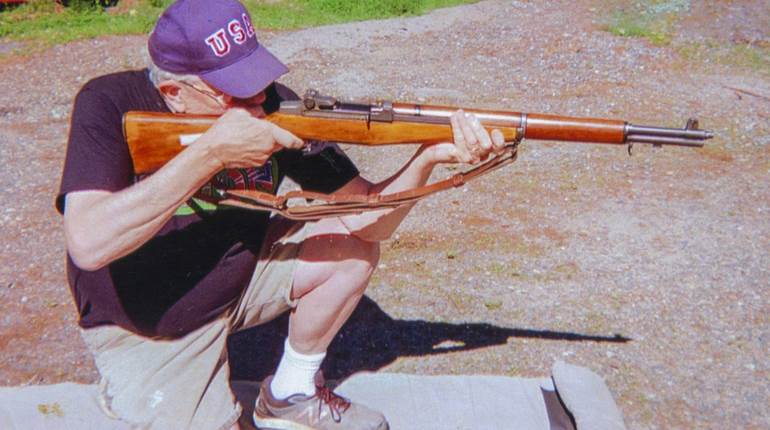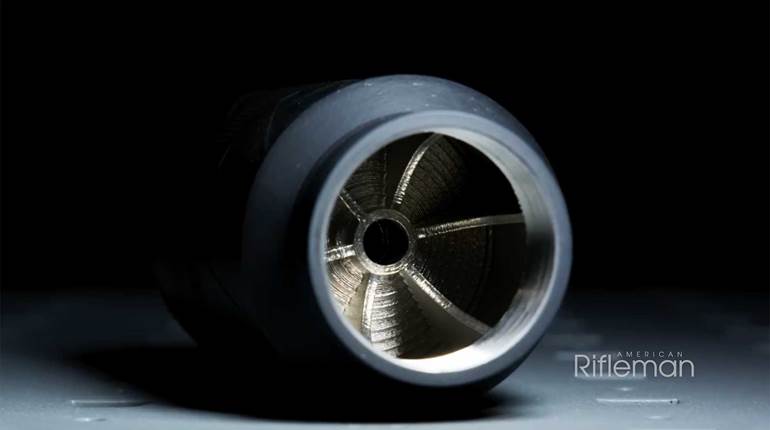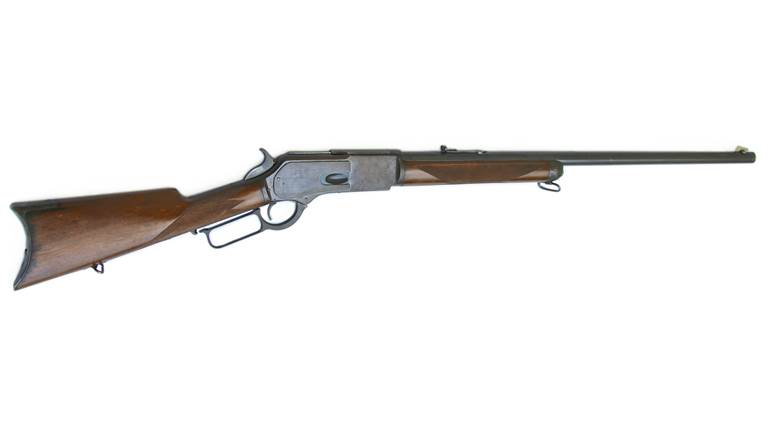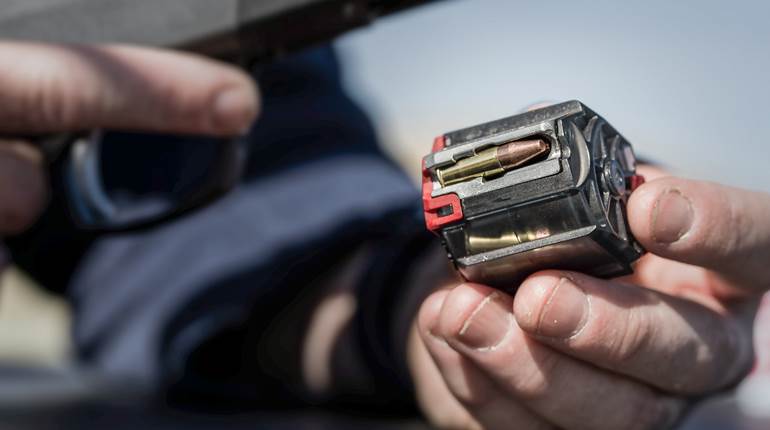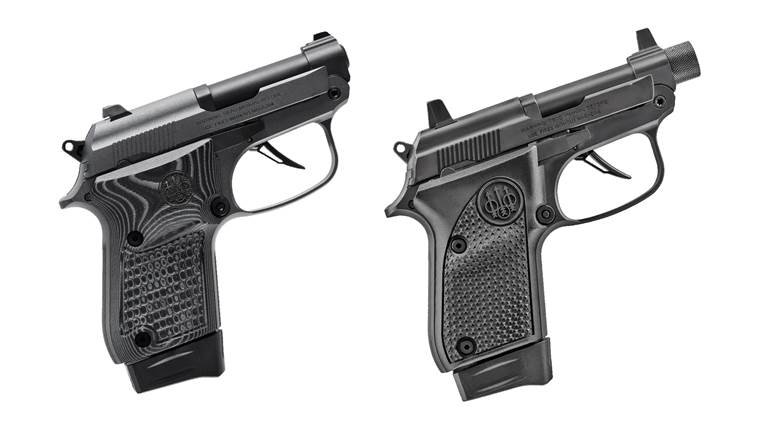
I've been researching and writing about the M1 carbine for some time now, and I've concluded that the carbine may be America's least understood military firearm. Assessments of the M1 carbine are quite literally all over the map. GIs and Marines from World War II through the Vietnam War don't hide their feelings when discussing the relative merits of the carbine in action.
Full disclosure: I am a huge fan of the little rifle. I've happily owned many and shot them in semi-automatic and fully automatic modes. For me, the M1 carbine always delivers. But I never used the carbine in action. I never carried it in combat to defend my life. Consequently, I had to put my personal feelings aside and simply gather as much information from the men who did use it. They provide the only opinions that really count in this case.
 The soldier’s pet: The M1 carbine in the hands of a U.S. artilleryman in Germany during the spring of 1945. Photo courtesy of author.
The soldier’s pet: The M1 carbine in the hands of a U.S. artilleryman in Germany during the spring of 1945. Photo courtesy of author.
I had read several negative reports about the accuracy and stopping power of handy little rifle that some have called "the soldiers' pet." These comments came from the Korean War, and I tended to discount them. With more than six million M1 carbines made during World War II, I explained away the Korean conflict's carbine complaints by assuming that there was some confusion with green troops hurriedly rushed into action on the Korean peninsula during 1950. Other issues may have come from rifles and ammunition improperly stored in depots in Japan post-World War II. Realizing that was a mistake, I began to look for carbine reports from World War II to see if I could find similar issues in the earlier conflict. I've collected them here, and you can be the judge.
 The M1 carbine as a personal defense weapon as seen with a USMC radioman on Tarawa, November 1943.
The M1 carbine as a personal defense weapon as seen with a USMC radioman on Tarawa, November 1943.
The Right Way, The Wrong Way & The Army Way
In a U.S. Army publication from the summer of 1944 titled "Combat Lessons," I found this interesting and entirely accurate assessment. It makes perfect sense, but I wonder how many commanders thought of this before they issued the special rifle.
Great stress was laid on the proper use of the carbine by Lt. Col. F. O. Hortell of the 45th Infantry Division because of operations at Anzio in March.
"When the carbine is used properly in lieu of the pistol it becomes a dangerous and accurate weapon, but when it is used in place of the M1 rifle, a grave mistake has been made. Always remember that any target that can be hit by a carbine can also be hit by an M1 rifle, but the reverse is not true."
 The paratroopers’ weapon: A member of the 101st Airborne carrying a pair of M1A1 folding stock carbines in Normandy during the D-Day landings.
The paratroopers’ weapon: A member of the 101st Airborne carrying a pair of M1A1 folding stock carbines in Normandy during the D-Day landings.
The colonel's point of using the right tool for the job, and for what purpose that tool was designed, is an important distinction. It appears that this is the root of the "problem(s)," and certainly the center of the carbine debate.
An earlier notation, found in the "Observer's Report North Africa, HQ Army Ground Forces, conducted 12-30-42 to 2-6-43", and dated March 5, 1943, describes the initial use of the M1 carbine in the Mediterranean Theater of Operations:
"Although the carbine is not in the bands of all troops whose T/O includes carbines, those who have them are well satisfied with them. As in the case of the 60mm vs the 81mm mortars, I have heard inexperienced officers disapprove of the carbine because it was not as effective as the M1 rifle. None has questioned its superiority over the pistol, caliber .45."
 An ideal arm for communications troops: With the 76th Infantry Division in Luxembourg, February 1945.
An ideal arm for communications troops: With the 76th Infantry Division in Luxembourg, February 1945.
Again, we find the dissatisfaction arising from unmet expectations. Apparently, unit commanders were not really familiar with the M1 carbine's abilities and shortcomings. Designed to replace the pistol and submachine gun for officers and specialty troops, the M1 carbine was not, and could not be a replacement for the full-size M1 Garand.
In the “Report of the New Weapons Board,” dated April 27, 1944, the board outlines the split decision on the M1 carbine from field commanders:
"The carbine is not popular with the infantry units in Italy. The main reason for this is that the personnel authorized the carbine are subject to fire chiefly from snipers, against which the carbine is ineffective. No solution or suggestions for a substitute were offered."
 Never meant for riflemen: Two Marines carry M1 carbines as third totes a M1 Garand rifle in the background. Saipan, July 1944.
Never meant for riflemen: Two Marines carry M1 carbines as third totes a M1 Garand rifle in the background. Saipan, July 1944.
Later in the New Weapons Board report, issues of range, accuracy, and striking power are brought up:
"The opinion as to the worth of the carbine is divided. Many officers expressed a high regard for this weapon, whereas others look upon it more or less as a toy with insufficient striking power. The officers in this latter group would rather carry a rifle or a submachine gun, and a few prefer the pistol. It is believed that more information on the striking power and accuracy of this weapon should be supplied to the theaters. The adjustable rear sight was immediately popular in both theaters, and a large demand for this item was established."
Meanwhile, massive amounts of M1 carbines were being issued to American troops, just in time for the big summer offensives in the European Theater of Operations (France) and in the Pacific Theater of Operations (Marianas Islands). Some combat units had been experimenting with their carbines, producing field-modified, full-auto versions and creating expedient bayonets. By the end of June 1944, the U.S. Infantry Board was working on a selective-fire version of the carbine and exploring some other interesting modifications.
 “A rifle fit for any GI”: An accurate description of size, but dependent on application.
“A rifle fit for any GI”: An accurate description of size, but dependent on application.
Report of the Infantry Board
U.S. carbine, Caliber .30, M1 with selective single shot or full automatic firing mechanism. Fort Benning, Georgia June 30, 1944
Factual Background: The U.S. carbine, Caliber .30, M1 is accepted as a highly successful weapon for the initial purpose for which it was designed. The potentialities of this weapon has led it into fields beyond the purpose of its original mission. It has been put to uses that were never intended for this weapon, such as grenade launching and bayonet combat. It has met these requirements successfully. It is now being subjected to automatic fire and possibly bipod mounting or field expedient mounts. The carbine is undergoing a cycle of applications common in the life of firearms."
"Potential" can be a dangerous word. The first line of the background says conclusively that the carbine was highly successful for the initial purpose it was designed. It seems that the desires of the American troops using the M1 carbine encouraged the U.S. Ordnance Dept. and the Infantry Board to look at the firearm beyond the scope of its original mission, regardless of the inherent shortcomings imposed by its short barrel and pistol-like ammunition. The comment about the "bipod mounting" made me cringe. Regardless of any potential difficulties, the M1 carbine was destined to become an automatic rifle, although the new "M2" would not be used in combat in World War II.
 As the infantryman’s load seemed to grow exponentially, the M1 carbine appeared, on the surface, to balance things out. Demonstrating the new Army overcoat and pack in the European Theater of Operations, late 1944.
As the infantryman’s load seemed to grow exponentially, the M1 carbine appeared, on the surface, to balance things out. Demonstrating the new Army overcoat and pack in the European Theater of Operations, late 1944.
“Every Marine a Rifleman”
Possibly the most damning assessment of the M1 carbine in World War II comes from U.S.M.C. Ordnance with the U.S. III Amphibious Corps, after the battle to retake Guam. In an Operations Report dated Aug. 22, 1944, the Marines outlined their complaints:
"Dissatisfaction with the carbine where assigned to front line combat troops was noted, The Commanding Officer of the 4th Marines expressed lack of confidence in its capabilities and hitting power. He stated that wherever possible his men in rifle squads, including the sergeants, armed with carbines were replacing them with M1 rifles.
Losses in the 77th Division, where the carbine was not carried by rifle squad members, were but 50, as compared to 625 in the First Provisional Marine Brigade, and 1082 in the 3rd Marine Division. The statement was often heard that the carbine will not stop a Jap unless he is hit in a vital spot. It can be safely deduced that the great bulk of the 1757 carbines lost were not carbines destroyed in action but rather carbines thrown away.
The men found that they preferred carrying the extra weight of the M1 rifle and its ammunition to taking a chance with the carbine. It is firmly believed that no effort should be made to employ the carbine other than as a replacement for the pistol for personnel requiring only a personal defense weapon. Its replacement in the rifle squad by the M1 rifle is recommended."
 The carbine goes full-auto and gets a 30-round magazine and bayonet. This publicity photo was dated March 1945. The full-auto M2 did not see combat in World War II.
The carbine goes full-auto and gets a 30-round magazine and bayonet. This publicity photo was dated March 1945. The full-auto M2 did not see combat in World War II.
This may seem a harsh assessment, but it is valid. Riflemen need true rifles. Any GI or Marine will want a light firearm, simply because they must carry it around with them. But saving weight will not save your life when the mission requires range, hitting power and the ability to penetrate cover. In France, U.S. Army units saw a similar transition in the late summer of 1944. Many carbines and submachine guns were exchanged for the more powerful M1 Garand rifle. As World War II progressed, it seems that needs trumped wants in terms of firepower versus weight. The M1 carbine appears to have naturally settled into its intended role of providing a personal defense weapon for officers and specialist troops.
Lieutenant Colonel John B. George offered his opinion of the M1 carbine in his excellent book: Shots Fired In Anger (first published in January 1947). In George’s view, the carbine’s light weight was the overriding factor in his approval:
“With the exception of the carbine and the new rifled rocket guns, our guns were too heavy.”
…The carbine turned out to be an ace weapon of this war, as far as I am concerned. It was light and handy, powerful, and reasonably accurate. If I had to make it on my own in a hostile jungle, travelling with the lightest possible kit where I should be likely to encounter enemy at any time, the carbine is the weapon I should choose.
The development of the carbine had the effect of putting a good offensive-defensive weapon in the hands of the leader and gun crew member, thereby making him the near-equal of an M1 rifleman. The cartridge was powerful enough to penetrate several thicknesses of helmet, and to perforate the plates of the Japanese bullet proof vests, which would only be dented by .45 auto slugs. It was flat shooting enough to have practical accuracy at more than two hundred yards. It would be interesting to know how many casualties it created during the war—certainly more than all the pistols and revolvers our military has ever used.
The great advantage was that it got a gun that could shoot into the hands of the average infantryman. The pistol, as far as general usage is concerned, is a purely defensive weapon, accurate only when in the hands of an expert. The carbine performed moderately well in the hands of dubs. For many types of offensive fighting, such as sneak raids and infiltration tactics, it was often superior even to the M1, penetration being the only point of difference.
The greatest advantage of the carbine was its light weight, which is the greatest advantage any Infantry weapon can have. Of all the guns we used in this war it is the only one which does not need further reduction in heft. The rest are all too heavy for the job they do.”
 A period of heightened complaints: A selective-fire M2 carbine at work in Korea during 1951.
A period of heightened complaints: A selective-fire M2 carbine at work in Korea during 1951.
Cold Front: The M1 Carbine In Korea
Probably the most damning report on carbine performance came from Brig. Gen. S.L.A. Marshall’s “Commentary on Infantry and Weapons in Korea 1950–51.” Marshall wrote extensively about the M1 carbine in his commentary, and it was hard news from the start:
“In subfreezing weather, the carbine operates sluggishly and, depending upon the degree of cold, will require anywhere from 5 to 20 warm-up shots before it will fire full automatic. Since being made full automatic, it is hypersensitive. In hot weather, even small amounts of dust and moisture together will cause it to misfire. In cold weather, it is more sensitive to frost than any other weapon, and more difficult to lubricate in such a way that it will remain operative. The magazines are a source of continuing trouble. After only a few weeks the clipped ammunition begins to corrode at the edges where it rubs the metal of the clip, and as the oxidization proceeds dirt becomes mixed with it. The discoloration is obvious, and the dirt can be scraped off with the fingernail. When the shell is injected, the fouled metal leaves its accumulation on the chamber. As this builds up, it gradually develops a block, and the piece goes out of action. There is no way to prevent such stoppages except by frequent unclipping and cleaning of the ammunition; time is insufficient for that.
The weapon lacks “power.” It is “too delicate.” Its day-to-day operation is “too variable,” according to changes in the weather. It was “more dependable” when it was semi-automatic. When fired full automatic, it “wastes ammunition.” When fired semi-automatic it isn’t sufficiently accurate for “aimed fire at moderate distances.”
These are a few of the criticisms voiced by troops who have used the carbine in Korean operations. The anvil chorus is much louder than during World War II operations, including the Pacific, where the carbine was hardly an outstanding success. The Marine criticism is even more harsh than that of the Army. From top to bottom, 1st Marine Division takes the dim view of this weapon; their experience with it during the Chosin Reservoir operation was the final blow to confidence. They want it either eliminated or made over into a dependable weapon.
 The lively cyclic rate of the M2 (750 rounds per minute) seduced many GIs into using their carbine as a submachine gun—producing middling results in the Korean War.
The lively cyclic rate of the M2 (750 rounds per minute) seduced many GIs into using their carbine as a submachine gun—producing middling results in the Korean War.
As to the issues of range and stopping power, Marshall was straight to the point:
“There are practically no data bearing on the accuracy of the carbine at ranges in excess of 50 yards. The record contains a few examples of carbine-aimed fire felling an enemy soldier at this distance or perhaps a little more. But they are so few in number that no general conclusion can be drawn from them. Where carbine fire had proved killing effect, approximately 95 percent of the time the target was dropped at less than 50 yards. Because of the frequency of hand-to-hand fighting in Korea operations, there has been a suitable opportunity for judging the takedown characteristics of the carbine round when delivered at close range. This is not a source of general complaint.
However, there is some illuminating comment. In the approximately 50 infantry actions covered, there were in all 7 witnesses who said that they had fired at an enemy soldier under conditions where there was no doubt that the bullet had struck him in a vital part of the body, and that he had kept on coming. One such witness is 1st Lt Joseph R. Fisher, 1st Marine Regiment. He was speaking of the defense at Hagaru-ri. The 1st Marine Division regarded him as one of its ablest and most objective company commanders. These were his words: “About 30 percent of our carbines gave us trouble; some wouldn’t fire at all; others responded sluggishly. But the main reason my men lost confidence in the carbine was because they would put a bullet right in a Chink’s chest at 25 yards range, and he wouldn’t stop. This happened to me. The bullet struck home; the man simply winced and kept on coming. There were about half a dozen of my men made this same complaint; some of them swore they had fired three or four times, hit the man each time, and still not stopped him.”
 Many of the carbine issues in the first winter of the Korean War can be traced to less-than maintenance and improper use. As the war continued, the carbine performance “improved” as troops learned the right situations to use it.
Many of the carbine issues in the first winter of the Korean War can be traced to less-than maintenance and improper use. As the war continued, the carbine performance “improved” as troops learned the right situations to use it.
The M1 Carbine In Vietnam
Aside from certain specialist troops, few American units in Vietnam were equipped with the M1 carbine after 1965. However, that didn’t mean that carbines were used by American fighting men in Southeast Asia. The M1 carbine was provided in large numbers to the ARVN and Popular Forces units. On the other side of the lines, Viet Cong guerrillas frequently used the carbine—which ultimately fit the smaller stature of Vietnamese troops, whichever side they were on.
To find out more about what a new generation of American fighting men thought of the M1 carbine, I turned to two good friends to share their experiences.
 The M1/M2 carbines were widely distributed among ARVN and Popular Front troops. Here, Marines work with “Kit Carson Scouts” during 1968.
The M1/M2 carbines were widely distributed among ARVN and Popular Front troops. Here, Marines work with “Kit Carson Scouts” during 1968.
Captain Dale Dye, USMC, first deployed to Vietnam during 1965:
"I carried an M1 carbine for quite a while in 1967 operating in the DMZ area of Vietnam. At the time, we were having some serious problems with the newly issued M16s, and Iike many other Marines who were being force-fed that rifle, I didn't trust it. I traded a carton of Salem cigarettes to an ARVN soldier for his carbine and several magazines of ammo. Fortunately, I didn't have to use it very much, except in a few close-quarter firefights. The carbine was reliable and easy to carry and maintain, but I always had to find another ARVN unit and do some trading to keep supplied with ammo.
During the few times I had an opportunity to use it on enemy troops in the field, I didn't bother shooting if they were at ranges much beyond 100 meters. I'd heard or read stories from World War II and Korea vets about the round being underpowered, but it seemed to work for me, especially with Marines at my side cranking away with M-14s. I recall examining some dead NVA that were full of bullet holes, some of which might have been inflicted by my carbine, but it was hard to tell much difference. What I can say is that it was light and handy for me, and I trusted it when the chips were down."
 With more than six million M1 carbines manufactured, the weapon was issued and used around the world during the Cold War. This USAF Air Policeman provides security at a US base in France during the mid-1950s.
With more than six million M1 carbines manufactured, the weapon was issued and used around the world during the Cold War. This USAF Air Policeman provides security at a US base in France during the mid-1950s.
Jim Wagner was a UH-1 helicopter crew chief and door gunner with the 9th Infantry Division in Vietnam during 1967:
"In South Vietnam, the M1 carbine was a great favorite of the Viet Cong, ARVN, Popular and Regional forces. I saw some U.S. Special Forces carrying them as well. In Vietnam, you normally saw the carbine used with the 30-round magazine, mainly because of its light weight, reliability and accuracy at shorter ranges.
Keep in mind, the average ARVN trooper or VC guerilla was only about 5 feet or so tall and of slender build. I used to feel sorry for any ARVN grunt that carried the BAR; it was almost as long as they were tall!
I saw the M1 carbine with most ARVN troops (except for their "Elite" units) until late 1968, when they began to receive the M16. I thought the carbine was a little light on stopping power as far as a single round goes, and I figured it would have been better if set for automatic fire, which I rarely saw. Personally, I liked the U.S. M3A1 .45 caliber "Grease Gun" SMG—it was light, simple, reliable, easy to clean and packed a heavy punch at close range. If you hit anyone with those big .45 pumpkins, they stay hit! We had one in our "Di Di Mau" escape bag just in case we had to walk home."
 The M1 carbine soldiered on into the Vietnam War. Here a U.S. sailor checks boat traffic on the Mekong during 1966.
The M1 carbine soldiered on into the Vietnam War. Here a U.S. sailor checks boat traffic on the Mekong during 1966.
The Final Assessment
Reading through this varied collection of combat assessments, the M1 carbine appears to have been judged based on the soldier or Marine’s expectation of what it could deliver. In some cases, probably too many, the carbine seems to have been “over-sold” or, at least, inappropriately issued. Too much rifle power was anticipated from a light rifle chambered for essentially a .30-cal. pistol round fired from a less-than-18” barrel. Love it or hate it, the M1 carbine was an excellent arm in the right circumstances—when misapplied, however, it was often a tool not up to the task. Knowledge is the ultimate power, and in the right hands at the right time, the M1 carbine proved itself as one of the great American firearms.












